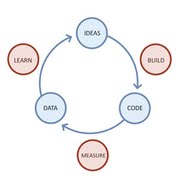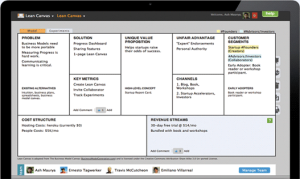Entrepreneurs are everywhere. The development of the internet has made creating and selling a product or service more accessible to more people than ever before. New technologies are dropping development costs while marketing and distribution costs are also decreasing. While some record executives might tell you that this is a bad thing, the rest of us are closer than ever before to being able to make our business ideas into realities. However, many entrepreneurs struggle with creating their idea because they are not technical. Today, one must either know how to build the product, ie. know how to code or hire someone who can. For many aspiring entrepreneurs this means hiring a development partner build their product. The problem is, most people don’t know how to hire a development shop, let alone run a technology product as a product owner. Often times, this means getting it wrong or paying someone to be your product owner which can be expensive too. And many times, entrepreneurs end up spending their entire budget before their product sees the light of day.
There is a better way. With a great deal of work and willingness to learn, you can build your product on a budget. With that in mind, here are 4, very high level tips (each section deserves it’s own post or posts) for non-technical entrepreneurs looking to build a web product.
1. Lean Into It:
 There are two books that I strongly recommend reading before starting a software or web based business. The first is The Lean Startup by Eric Ries which lays out the case for iteration in your business. The book will tell you how to talk to your customers and potential customers to uncover false assumptions and hidden value. Most importantly, the book is choc full of tips for eliminating wasted investments as well as advice for how to spend your time on the right activities to make your business a success.
There are two books that I strongly recommend reading before starting a software or web based business. The first is The Lean Startup by Eric Ries which lays out the case for iteration in your business. The book will tell you how to talk to your customers and potential customers to uncover false assumptions and hidden value. Most importantly, the book is choc full of tips for eliminating wasted investments as well as advice for how to spend your time on the right activities to make your business a success.
As a second read, I recommend picking up Lean UX for Startups by Laura Klein. Klein’s book is the perfect companion to The Lean Startup covering UX and testing concepts in plain, easy to understand language. In addition to equipping you to run more tests on your own, you’ll increase your understanding of UX which will make you a much better product owner when you build your product.
2. Document Your Business Idea
 Nope, it’s not time for a pitch deck (yet) and definitely not time to start a business plan (what a waste). Instead, take what you learned from the The Lean Startup and create your business canvas. This is where you will capture the high level, important facets of your business. There are quite a few varieties, the Lean Canvas or Javelin Board for example. They are all based off of Alex Osterwalder’s Business Model Canvas. This is the place you document the assumptions you test, learnings you discover and eventually your market and revenue streams. This canvas will be your record keeper as you iterate towards your business. After reading a few books and creating a business canvas, you are ready to start testing.
Nope, it’s not time for a pitch deck (yet) and definitely not time to start a business plan (what a waste). Instead, take what you learned from the The Lean Startup and create your business canvas. This is where you will capture the high level, important facets of your business. There are quite a few varieties, the Lean Canvas or Javelin Board for example. They are all based off of Alex Osterwalder’s Business Model Canvas. This is the place you document the assumptions you test, learnings you discover and eventually your market and revenue streams. This canvas will be your record keeper as you iterate towards your business. After reading a few books and creating a business canvas, you are ready to start testing.
3. Draft Wireframes
 Now that you have the background in The Lean Startup and a scorecard, it’s time to start learning. You may have some assumptions to validate without showing potential customers anything at all. You might just need to talk to people as a first step. Get out of the building! Simple interviews can be a great place to start your customer development interviews. There are many ways to test your riskiest assumptions but once you decide you want to build something, you’ll want to build out some wireframes to describe how your product will look and function. You may be saying to yourself that you are not a designer and can’t do wireframes but there are many tools like Basalmiq that make it very easy to mock up simple wireframes (think-computer aided sketches). You can use these wireframes to do even more customer development before talking to a development shop.
Now that you have the background in The Lean Startup and a scorecard, it’s time to start learning. You may have some assumptions to validate without showing potential customers anything at all. You might just need to talk to people as a first step. Get out of the building! Simple interviews can be a great place to start your customer development interviews. There are many ways to test your riskiest assumptions but once you decide you want to build something, you’ll want to build out some wireframes to describe how your product will look and function. You may be saying to yourself that you are not a designer and can’t do wireframes but there are many tools like Basalmiq that make it very easy to mock up simple wireframes (think-computer aided sketches). You can use these wireframes to do even more customer development before talking to a development shop.
4. Write user stories and rank them
After building your wireframes and getting feedback on them from potential customers, you are ready to start writing user stories. The user stories will be used as guidelines for the conversations around the features that you want to build. Create the user stories on notecards or using a tool like Trello and then rank them in importance to the value they bring to your product. You will want to put the most important features (your special sauce) at the top of the list and leave rote features like login or my account for later.
Now, you are finally ready to talk to development shops. This may seem like a ton of work just to get ready to speak with a development partner but it’s the best approach if you want to save money. By following the Lean process you will be better positioned to avoid building the wrong thing as well as more knowledgeable about the product that you want to build. Knowing exactly what you want to build is the most important thing you can do to make your project work once you’ve decided to hire a partner, Be an active product manager. If you want your product to be successful you will need to be actively involved in the project, setting priorities (and cutting those features that don’t move the client needle), approving designs, taking early versions of the product out for feedback and making sure that the learning you have done finds it’s way to your product.
Want to talk more about any of these steps? Contact me here!

Recent Comments